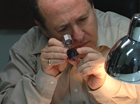Some laboratories were quick to produce thousands of reports for beautiful Padparadcha.
Sapphires, not suspecting the obvious question of how come?
It shook the world of gems, it ruined the faith of some major consuming centers, which are refusing to use sapphires unless free of any treatment. It caused what I call, the ETQ or “excess time for questions” during sale times, when you or your sales person are spending time to explain that your gems are OK instead of concentrating on how beautiful they are. Such is the case now with the new corundum treatment. They take low quality rough semi opaque corundum, full of cracks, fissures and cavities, pre-clean the material from the material in the fissures and impregnate the cracks with lead and some silica. The effect is startling. Those opaque cracks allow the light to travel through the material resulting in a rubylike material, comparable to a ruby worth many folds the ugly rough it originated from. And then came certificates:
In the Bangkok fair a few days ago, I saw a certificate (which was part of a pile of fresh certificates) clearly stating that the stone was a natural ruby, natural corundum and as a comment in the bottom a mention to the effect that some glass (lead) has been found in features.
How far do we have to go with treatments in order to lose the magic word natural? Will a product made out of natural powdered corundum impregnated with glass and lead still be called natural ruby?
We are going way too far.
Well friends let’s clear things up.
A ruby is a natural red corundum with chromium and iron as the coloring elements.
It is not a treated corundum filled with lead. The product is not a natural ruby, it is not even a natural corundum. It should be properly called: treated corundum, impregnated by lead to create an imitation ruby.
Let us protect what is sacred and not abuse the word natural.
Let us protect natural with a separate natural certificate, which will look different from the treated gems certificate.
Let’s cherish those precious gems for that which sets them apart from the crowd - they are natural.
Regards
The GemEWizard
Copyright © IDEX
[ 1 comment ] ( 469 views ) | permalink | related link |




 ( 3 / 3796 )
( 3 / 3796 )
 THE ABUSE OF ALL THAT IS NATURAL
THE ABUSE OF ALL THAT IS NATURAL Calendar
Calendar